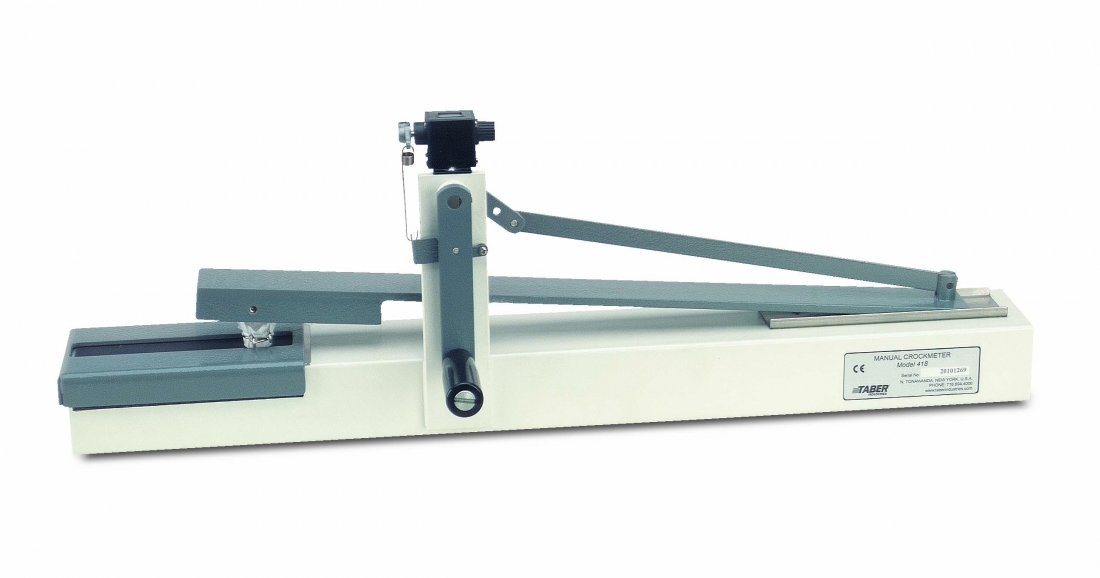Crockmeter 
 The Taber® Crockmeter - Model 418 provides a quick and accurate method to determine the amount of color transferred from textile materials (such as fabric, carpeting, yarn and leather) to other surfaces by rubbing. The Crockmeter has also been employed to perform rub abrasion, scuff and / or mar tests on flat specimens. Plus, it can be used to conduct smudge and smear resistance tests on images produced by a printer or copier. Regardless of specimen material, both wet and dry testing can be performed.
The Taber® Crockmeter - Model 418 provides a quick and accurate method to determine the amount of color transferred from textile materials (such as fabric, carpeting, yarn and leather) to other surfaces by rubbing. The Crockmeter has also been employed to perform rub abrasion, scuff and / or mar tests on flat specimens. Plus, it can be used to conduct smudge and smear resistance tests on images produced by a printer or copier. Regardless of specimen material, both wet and dry testing can be performed.Description
Originally designed to simulate the action of a human finger and forearm, the Crockmeter uses a standard pressure and rubbing motion to provide reliable and reproducible test results. Specimens are positioned on the base of the Crockmeterand held in place with the sample holder. To prevent the specimen from shifting during testing, a sandpaper pad is provided to place under the specimen. A hand crank moves a reciprocating arm a distance of approximately 100mm. The rubbing action is provided by a 16mm diameter acrylic "finger" which moves back and forth in a straight line with each complete turn of the crank. The reciprocating load arm is weighted to provide a constant 9N load on the sample at all times and a mechanical counter keeps track of completed cycles.
Abradants
A standardized crocking cloth is most often used as the abradant for textile applications. This square (or sometimes circular) cloth is wrapped around the acrylic crock "finger" and held in place with a wire spring clip. AATCC Method 8 specifies the cloth should meet the following specifications:
Fiber
|
100% 10.3 - 16.8mm combed cotton staple, desized, bleached, with no optical brightener or finishing material present
|
Yarn
|
15
|
Thread Count
|
32 +/-3 warp ends/cm: 33 +/-3 picks filling/cm
|
Weave
|
1/1 plain
|
pH
|
7 +/-0.5
|
Mass/sq. meter
|
113 +/-5g greige: 100 +/-3 g finished)
|
Whiteness
|
W = 80 +/-2
|
Other abradants that might be used with the Crockmeter include felt, duck cloth, laboratory grade denim, coated abrasives (e.g. Polishing Paper, 281Q 3M WetorDry™), etc.
Evaluation
Typical evaluation for textile Crockmeter tests involve visually comparing the amount of color transfer / staining against a standardized color transfer scale. After rubbing the crocking cloth against a colored test specimen for the prescribed cycles, the crocking cloth is removed from the instrument and the amount of color transferred to it is compared to a known scale and assigned a grade. Two popular scales include AATCC Gray Scale for Staining or the Chromatic Transference Scale. For repeatable and reproducible test results, it is recommended that specimens be evaluated in controlled lighting and at a specified angle.
When using the standard 16mm diameter crock finger to test pile fabrics (such as textile floor coverings), there may be heavier staining on the circumference of the stained area of the crocking cloth. To resolve this, Test Method AATCC 165 describes using a "crock block" measuring 19.0 x 25.4mm.
Test Methods
The following link provides a listing of test methods the Taber Crockmeter (Crock Meter) satisfies. Please note, additional accessories may be required.
than make up something on the spot "to make the sale." Unfortunately, this is not always the case. taber Abrasion Tester TF214
ตอบลบThe TESTEX Electronic Crockmeter(Crock Meter) performs well in the colorfastness test of textiles. Except for the simple Crockmeter test method, it also provides reliable and reproducible test results. Welcome to contact us.
ตอบลบ